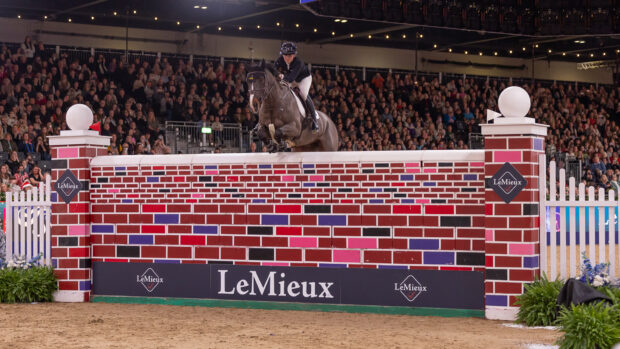Gridwork is often known as gymnastic jumping, because it helps teach the horse to be more elastic and enables both horse and rider to hone certain techniques without worrying about the perfect stride. Grids are typically set up on slightly short distances – seven yards to one horse’s non-jumping stride rather than the eight you’ll see used in competition – to encourage the horse to be sharp with his front legs and not flatten. However, in this session, Gemma Stevens chooses a gridwork format set out on “true competition striding”.
“This grid is inspired by my friend [CCI5* winner] Laura Collett , who uses it sometimes when she’s schooling racehorses,” says Gemma Stevens, an international showjumper and event rider who won eventing team gold at the 2018 World Equestrian Games. “It’s amazingly useful for getting horses to be more careful when jumping out of their normal stride.”
{"content":"PGRpdiBpZD0iYXR0YWNobWVudF84ODM4OTMiIHN0eWxlPSJ3aWR0aDogMTQxMHB4IiBjbGFzcz0id3AtY2FwdGlvbiBhbGlnbm5vbmUiPjxpbWcgZmV0Y2hwcmlvcml0eT0iaGlnaCIgZGVjb2Rpbmc9ImFzeW5jIiBhcmlhLWRlc2NyaWJlZGJ5PSJjYXB0aW9uLWF0dGFjaG1lbnQtODgzODkzIiBjbGFzcz0ibGF6eWxvYWQgYmx1ci11cCBzaXplLWZ1bGwgd3AtaW1hZ2UtODgzODkzIiBkYXRhLXByb2Nlc3NlZCBzcmM9Imh0dHBzOi8va2V5YXNzZXRzLnRpbWVpbmN1ay5uZXQvaW5zcGlyZXdwL2xpdmUvd3AtY29udGVudC91cGxvYWRzL3NpdGVzLzE0LzIwMTcvMDMvbmV3LWhoLXBsYWNlaG9sZGVyLTIwMHgyMDAucG5nIiBkYXRhLXNyYz0iaHR0cHM6Ly9rZXlhc3NldHMudGltZWluY3VrLm5ldC9pbnNwaXJld3AvbGl2ZS93cC1jb250ZW50L3VwbG9hZHMvc2l0ZXMvMTQvMjAyNS8wMi9tYXJ0aGEtZGlhZ3JhbS03XzItMi5qcGciIGFsdD0iR3JpZHdvcmsgcGF0dGVybiIgd2lkdGg9IjE0MDAiIGhlaWdodD0iNzg4IiBkYXRhLXNpemVzPSJhdXRvIiBkYXRhLXNyY3NldD0iaHR0cHM6Ly9rZXlhc3NldHMudGltZWluY3VrLm5ldC9pbnNwaXJld3AvbGl2ZS93cC1jb250ZW50L3VwbG9hZHMvc2l0ZXMvMTQvMjAyNS8wMi9tYXJ0aGEtZGlhZ3JhbS03XzItMi5qcGcgMTQwMHcsIGh0dHBzOi8va2V5YXNzZXRzLnRpbWVpbmN1ay5uZXQvaW5zcGlyZXdwL2xpdmUvd3AtY29udGVudC91cGxvYWRzL3NpdGVzLzE0LzIwMjUvMDIvbWFydGhhLWRpYWdyYW0tN18yLTItMzAweDE2OS5qcGcgMzAwdywgaHR0cHM6Ly9rZXlhc3NldHMudGltZWluY3VrLm5ldC9pbnNwaXJld3AvbGl2ZS93cC1jb250ZW50L3VwbG9hZHMvc2l0ZXMvMTQvMjAyNS8wMi9tYXJ0aGEtZGlhZ3JhbS03XzItMi02MzB4MzU1LmpwZyA2MzB3LCBodHRwczovL2tleWFzc2V0cy50aW1laW5jdWsubmV0L2luc3BpcmV3cC9saXZlL3dwLWNvbnRlbnQvdXBsb2Fkcy9zaXRlcy8xNC8yMDI1LzAyL21hcnRoYS1kaWFncmFtLTdfMi0yLTEzNXg3Ni5qcGcgMTM1dywgaHR0cHM6Ly9rZXlhc3NldHMudGltZWluY3VrLm5ldC9pbnNwaXJld3AvbGl2ZS93cC1jb250ZW50L3VwbG9hZHMvc2l0ZXMvMTQvMjAyNS8wMi9tYXJ0aGEtZGlhZ3JhbS03XzItMi0zMjB4MTgwLmpwZyAzMjB3LCBodHRwczovL2tleWFzc2V0cy50aW1laW5jdWsubmV0L2luc3BpcmV3cC9saXZlL3dwLWNvbnRlbnQvdXBsb2Fkcy9zaXRlcy8xNC8yMDI1LzAyL21hcnRoYS1kaWFncmFtLTdfMi0yLTYyMHgzNDkuanBnIDYyMHcsIGh0dHBzOi8va2V5YXNzZXRzLnRpbWVpbmN1ay5uZXQvaW5zcGlyZXdwL2xpdmUvd3AtY29udGVudC91cGxvYWRzL3NpdGVzLzE0LzIwMjUvMDIvbWFydGhhLWRpYWdyYW0tN18yLTItOTIweDUxOC5qcGcgOTIwdywgaHR0cHM6Ly9rZXlhc3NldHMudGltZWluY3VrLm5ldC9pbnNwaXJld3AvbGl2ZS93cC1jb250ZW50L3VwbG9hZHMvc2l0ZXMvMTQvMjAyNS8wMi9tYXJ0aGEtZGlhZ3JhbS03XzItMi0xMjIweDY4Ny5qcGcgMTIyMHciIHNpemVzPSIobWF4LXdpZHRoOiAxNDAwcHgpIDEwMHZ3LCAxNDAwcHgiIC8+PHAgaWQ9ImNhcHRpb24tYXR0YWNobWVudC04ODM4OTMiIGNsYXNzPSJ3cC1jYXB0aW9uLXRleHQiPlRoZSBzZXQtdXA6IGZvdXIgZmVuY2VzIHdpdGggb25lIHN0cmlkZSBiZXR3ZWVuIGVhY2gg4oCTIGFuZCBhIHBsYWNpbmcgcG9sZSAzeWQgaW4gZnJvbnQgb2YgZWFjaCBmZW5jZTwvcD48L2Rpdj4KPHA+4oCcSGVhdnkgY2FudGVyIHBvbGVzIHRoYXQgZG9u4oCZdCByb2xsIGFyZSBhIG11c3QgZm9yIHRoZSBwbGFjaW5nIHBvbGVzLOKAnSBzaGUgYWRkcy4g4oCcSSBhbSB0ZWFjaGluZyB0aGUgaG9yc2UgdG8gYmUgY2FyZWZ1bCBieSBiZWluZyBhd2FyZSBvZiB3aGVyZSB0aGV5IGFyZSBwdXR0aW5nIHRoZWlyIGZlZXQuIEFuZCBpdOKAmXMgc2FmZXIgYmVjYXVzZSBpZiB0aGV5IHJvbGwgdW5kZXIgdGhlIGhvcnNl4oCZcyBmb290IHRoZXkgY2FuIHR1cm4gYW4gYW5rbGUuIEnigJltIGp1c3QgdXNpbmcgYmlnIGhlYXZ5IHBvbGVzLCBidXQgeW91IGNhbiBhbHNvIHJhaXNlIHRoZW0gb24gYSBzbWFsbCBibG9jay48L3A+CjxwPjxzZWN0aW9uIGlkPSJlbWJlZF9jb2RlLTMxIiBjbGFzcz0iaGlkZGVuLW1kIGhpZGRlbi1sZyBzLWNvbnRhaW5lciBzdGlja3ktYW5jaG9yIGhpZGUtd2lkZ2V0LXRpdGxlIHdpZGdldF9lbWJlZF9jb2RlIHByZW1pdW1faW5saW5lXzIiPjxzZWN0aW9uIGNsYXNzPSJzLWNvbnRhaW5lciBsaXN0aW5nLS1zaW5nbGUgbGlzdGluZy0tc2luZ2xlLXNoYXJldGhyb3VnaCBpbWFnZS1hc3BlY3QtbGFuZHNjYXBlIGRlZmF1bHQgc2hhcmV0aHJvdWdoLWFkIHNoYXJldGhyb3VnaC1hZC1oaWRkZW4iPg0KICA8ZGl2IGNsYXNzPSJzLWNvbnRhaW5lcl9faW5uZXIiPg0KICAgIDx1bD4NCiAgICAgIDxsaSBpZD0ibmF0aXZlLWNvbnRlbnQtbW9iaWxlIiBjbGFzcz0ibGlzdGluZy1pdGVtIj4NCiAgICAgIDwvbGk+DQogICAgPC91bD4NCiAgPC9kaXY+DQo8L3NlY3Rpb24+PC9zZWN0aW9uPjwvcD4KPHA+4oCcRWFjaCBmZW5jZSBoYXMgYSBwbGFjaW5nIHBvbGUgM3lkIGluIGZyb250LCB3aGljaCBtYWtlcyB0aGUgaG9yc2UgZG8gYSBsaXR0bGUganVtcCBvbiB0aGUgZmluYWwgc3RlcCBiZWZvcmUgdGFraW5nIG9mZiBvdmVyIHRoZSBmZW5jZSwgd2hpY2ggZW5jb3VyYWdlcyB0aGVtIHRvIHBpY2sgdGhlaXIgZnJvbnQgbGVncyB1cC48L3A+CjxwPuKAnFRoZSBkaXN0YW5jZXMgZm9yIHRoaXMgZ3JpZCBhcmUgdHJ1ZSwgYmVjYXVzZSBJIGRvbuKAmXQgd2FudCB0aGUgaG9yc2UgYmFja2luZyBvZmYuIEl0IGlzIGRlc2lnbmVkIHRvIG1ha2UgdGhlbSBzaXQgYmFjaywganVtcCB0aGUgcG9sZSBhbmQgdGhlbiBzbmFwIHVwLuKAnTwvcD4KPGgyPkdyaWR3b3JrIHdpdGggR2VtbWEgU3RldmVuczwvaDI+CjxwPkdlbW1hIHdhcm1zIHVwIGhlciBmaXJzdCBob3JzZSwgYW4gYWR2YW5jZWQgZXZlbnRlciwgZm9yIDEwLTE1IG1pbnV0ZXMgaW4gd2FsaywgdHJvdCBhbmQgY2FudGVyLiBTaGUgaW5jb3Jwb3JhdGVzIHRyYW5zaXRpb25zLCBmbHlpbmcgY2hhbmdlcyBhbmQgbWFrZXMgc3VyZSB0aGUgbWFyZSBpcyBsaXN0ZW5pbmcgdG8gaGVyIGFpZHMuPC9wPgoKPHA+QWZ0ZXIgY2FudGVyaW5nIGRvd24gdGhlIGxpbmUgd2l0aCB0aGUgcG9sZXMgb24gdGhlIGdyb3VuZCwganVzdCB0byBmYW1pbGlhcmlzZSB0aGUgaG9yc2Ugd2l0aCB0aGUgdGFzayBpbiBoYW5kLCBHZW1tYSBzaG93cyB0aGUgbWFyZSB0aGUgZmlyc3QgZmVuY2UgcHJpb3IgdG8gYXNraW5nIGhlciB0byBqdW1wIGl0LjwvcD4KPHA+PGRpdiBpZD0iYXR0YWNobWVudF84ODM3NDUiIHN0eWxlPSJ3aWR0aDogMTQxMHB4IiBjbGFzcz0id3AtY2FwdGlvbiBhbGlnbm5vbmUiPjxpbWcgZGVjb2Rpbmc9ImFzeW5jIiBhcmlhLWRlc2NyaWJlZGJ5PSJjYXB0aW9uLWF0dGFjaG1lbnQtODgzNzQ1IiBjbGFzcz0ibGF6eWxvYWQgYmx1ci11cCBzaXplLWZ1bGwgd3AtaW1hZ2UtODgzNzQ1IiBkYXRhLXByb2Nlc3NlZCBzcmM9Imh0dHBzOi8va2V5YXNzZXRzLnRpbWVpbmN1ay5uZXQvaW5zcGlyZXdwL2xpdmUvd3AtY29udGVudC91cGxvYWRzL3NpdGVzLzE0LzIwMTcvMDMvbmV3LWhoLXBsYWNlaG9sZGVyLTIwMHgyMDAucG5nIiBkYXRhLXNyYz0iaHR0cHM6Ly9rZXlhc3NldHMudGltZWluY3VrLm5ldC9pbnNwaXJld3AvbGl2ZS93cC1jb250ZW50L3VwbG9hZHMvc2l0ZXMvMTQvMjAyNS8wMi9EU0MwNjgzXzQxMzk5MDg0MV83NjA4MjkzMDEuanBnIiBhbHQ9IkhvcnNlIGNhbnRlcmluZyBkb3duIGEgZ3JpZHdvcmsgbGluZSIgd2lkdGg9IjE0MDAiIGhlaWdodD0iODA4IiBkYXRhLXNpemVzPSJhdXRvIiBkYXRhLXNyY3NldD0iaHR0cHM6Ly9rZXlhc3NldHMudGltZWluY3VrLm5ldC9pbnNwaXJld3AvbGl2ZS93cC1jb250ZW50L3VwbG9hZHMvc2l0ZXMvMTQvMjAyNS8wMi9EU0MwNjgzXzQxMzk5MDg0MV83NjA4MjkzMDEuanBnIDE0MDB3LCBodHRwczovL2tleWFzc2V0cy50aW1laW5jdWsubmV0L2luc3BpcmV3cC9saXZlL3dwLWNvbnRlbnQvdXBsb2Fkcy9zaXRlcy8xNC8yMDI1LzAyL0RTQzA2ODNfNDEzOTkwODQxXzc2MDgyOTMwMS0zMDB4MTczLmpwZyAzMDB3LCBodHRwczovL2tleWFzc2V0cy50aW1laW5jdWsubmV0L2luc3BpcmV3cC9saXZlL3dwLWNvbnRlbnQvdXBsb2Fkcy9zaXRlcy8xNC8yMDI1LzAyL0RTQzA2ODNfNDEzOTkwODQxXzc2MDgyOTMwMS02MzB4MzY0LmpwZyA2MzB3LCBodHRwczovL2tleWFzc2V0cy50aW1laW5jdWsubmV0L2luc3BpcmV3cC9saXZlL3dwLWNvbnRlbnQvdXBsb2Fkcy9zaXRlcy8xNC8yMDI1LzAyL0RTQzA2ODNfNDEzOTkwODQxXzc2MDgyOTMwMS0xMzV4NzguanBnIDEzNXcsIGh0dHBzOi8va2V5YXNzZXRzLnRpbWVpbmN1ay5uZXQvaW5zcGlyZXdwL2xpdmUvd3AtY29udGVudC91cGxvYWRzL3NpdGVzLzE0LzIwMjUvMDIvRFNDMDY4M180MTM5OTA4NDFfNzYwODI5MzAxLTMyMHgxODUuanBnIDMyMHcsIGh0dHBzOi8va2V5YXNzZXRzLnRpbWVpbmN1ay5uZXQvaW5zcGlyZXdwL2xpdmUvd3AtY29udGVudC91cGxvYWRzL3NpdGVzLzE0LzIwMjUvMDIvRFNDMDY4M180MTM5OTA4NDFfNzYwODI5MzAxLTYyMHgzNTguanBnIDYyMHcsIGh0dHBzOi8va2V5YXNzZXRzLnRpbWVpbmN1ay5uZXQvaW5zcGlyZXdwL2xpdmUvd3AtY29udGVudC91cGxvYWRzL3NpdGVzLzE0LzIwMjUvMDIvRFNDMDY4M180MTM5OTA4NDFfNzYwODI5MzAxLTkyMHg1MzEuanBnIDkyMHcsIGh0dHBzOi8va2V5YXNzZXRzLnRpbWVpbmN1ay5uZXQvaW5zcGlyZXdwL2xpdmUvd3AtY29udGVudC91cGxvYWRzL3NpdGVzLzE0LzIwMjUvMDIvRFNDMDY4M180MTM5OTA4NDFfNzYwODI5MzAxLTEyMjB4NzA0LmpwZyAxMjIwdyIgc2l6ZXM9IihtYXgtd2lkdGg6IDE0MDBweCkgMTAwdncsIDE0MDBweCIgLz48cCBpZD0iY2FwdGlvbi1hdHRhY2htZW50LTg4Mzc0NSIgY2xhc3M9IndwLWNhcHRpb24tdGV4dCI+QmVmb3JlIHN0YXJ0aW5nIGp1bXBpbmcsIEdlbW1hIGNhbnRlcnMgZG93biB0aGUgbGluZSB3aXRoIHRoZSBwb2xlcyBvbiB0aGUgZ3JvdW5kIHRvIGZhbWlsaWFyaXNlIHRoZSBob3JzZSB3aXRoIHRoZSB0YXNrIGFoZWFkLiBOb3RlIHRoZSBwbGFjaW5nIHBvbGUgM3lkIGluIGZyb250IG9mIHdoZXJlIHRoZSBmZW5jZSB3aWxsIGJlIHRvIGVuY291cmFnZSB0aGUgaG9yc2UgdG8gYmUgcXVpY2sgd2l0aCB0aGVpciBmcm9udCBsZWdzLiBDcmVkaXQ6IEx1Y3kgTWVycmVsbDwvcD48L2Rpdj48YnIgLz4KPC9wPgo8cD7igJxTaGUgY2FuIGJlIGEgbW9ua2V5IGF0IHRoZSBmaXJzdCwgc28gSSBhbHdheXMgc2hvdyBoZXIgaXQgYmVmb3JlIHdlIHN0YXJ0IGp1bXBpbmcs4oCdIEdlbW1hIGV4cGxhaW5zLiDigJxJdOKAmXMgaGVyIHF1aXJrIGJ1dCBJIGRvbuKAmXQgbGV0IGl0IGJvdGhlciBtZS4gU2hl4oCZcyBhbiBhbWF6aW5nIHNob3dqdW1wZXIgYW5kIGhhcyByZWFsIGZpZ2h0IGFib3V0IGhlcjsgaXTigJlzIHdoYXQgbWFrZXMgaGVyIHNvIGdvb2QuIEJ1dCBzaGUgY2FuIGJlIHJlYWxseSBzcG9va3ksIGV2ZW4gaW4gdGhlIHNjaG9vbC7igJ08L3A+CjxwPkdlbW1hIGJ1aWxkcyB1cCB0aGUgZ3JpZCBmZW5jZSBieSBmZW5jZSwgc3RhcnRpbmcgd2l0aCBhIDJmdCA5aW4gdmVydGljYWwuIEdlbW1hIHBvaW50cyBvdXQgdGhhdCBpdOKAmXMgaW1wb3J0YW50IHRvIGhhdmUgYSBoZWxwZXIgb24gdGhlIGdyb3VuZCB0byBhZGp1c3QgdGhlIGZlbmNlcyBzbyB0aGF0IHNoZSBjYW4ga2VlcCBjb21pbmcg4oCTIG9mZiBib3RoIHJlaW5zIOKAkyB3aXRoIGEgZmVuY2UgYWRkZWQgZWFjaCB0aW1lIHNoZSBjb21wbGV0ZXMgdGhlIGxpbmUuIFRoZSBncmlkIGJ1aWxkcyB1cCByYXBpZGx5IGludG8gYSB2ZXJ0aWNhbCB0byB0d28gb3hlcnMgd2l0aCBhIGZpbmFsIHZlcnRpY2FsIHRvIGZpbmlzaC4gQWx0aG91Z2ggR2VtbWEgaGFzIGEgbGFyZ2UgYXJlbmEsIHNoZSBzYXlzIGl0IHdvdWxkIGJlIGRvYWJsZSBpbiBhIHNob3J0IGFyZW5hIHdpdGgganVzdCB0aHJlZSBmZW5jZXMgcmF0aGVyIHRoYW4gZm91ci48L3A+CjxwPjxiciAvPgo8ZGl2IGlkPSJhdHRhY2htZW50Xzg4Mzc0NCIgc3R5bGU9IndpZHRoOiAxNDczcHgiIGNsYXNzPSJ3cC1jYXB0aW9uIGFsaWdubm9uZSI+PGltZyBkZWNvZGluZz0iYXN5bmMiIGFyaWEtZGVzY3JpYmVkYnk9ImNhcHRpb24tYXR0YWNobWVudC04ODM3NDQiIGNsYXNzPSJsYXp5bG9hZCBibHVyLXVwIHNpemUtZnVsbCB3cC1pbWFnZS04ODM3NDQiIGRhdGEtcHJvY2Vzc2VkIHNyYz0iaHR0cHM6Ly9rZXlhc3NldHMudGltZWluY3VrLm5ldC9pbnNwaXJld3AvbGl2ZS93cC1jb250ZW50L3VwbG9hZHMvc2l0ZXMvMTQvMjAxNy8wMy9uZXctaGgtcGxhY2Vob2xkZXItMjAweDIwMC5wbmciIGRhdGEtc3JjPSJodHRwczovL2tleWFzc2V0cy50aW1laW5jdWsubmV0L2luc3BpcmV3cC9saXZlL3dwLWNvbnRlbnQvdXBsb2Fkcy9zaXRlcy8xNC8yMDI1LzAyL3NldC11cF9EU0MwNzQ5XzQxMzk5MTMxMl83NjA4MjkzMDEuanBnIiBhbHQ9IkdlbW1hIFN0ZXZlbnMgZ3JpZHdvcmsgc2V0LXVwIiB3aWR0aD0iMTQ2MyIgaGVpZ2h0PSI3ODkiIGRhdGEtc2l6ZXM9ImF1dG8iIGRhdGEtc3Jjc2V0PSJodHRwczovL2tleWFzc2V0cy50aW1laW5jdWsubmV0L2luc3BpcmV3cC9saXZlL3dwLWNvbnRlbnQvdXBsb2Fkcy9zaXRlcy8xNC8yMDI1LzAyL3NldC11cF9EU0MwNzQ5XzQxMzk5MTMxMl83NjA4MjkzMDEuanBnIDE0NjN3LCBodHRwczovL2tleWFzc2V0cy50aW1laW5jdWsubmV0L2luc3BpcmV3cC9saXZlL3dwLWNvbnRlbnQvdXBsb2Fkcy9zaXRlcy8xNC8yMDI1LzAyL3NldC11cF9EU0MwNzQ5XzQxMzk5MTMxMl83NjA4MjkzMDEtMzAweDE2Mi5qcGcgMzAwdywgaHR0cHM6Ly9rZXlhc3NldHMudGltZWluY3VrLm5ldC9pbnNwaXJld3AvbGl2ZS93cC1jb250ZW50L3VwbG9hZHMvc2l0ZXMvMTQvMjAyNS8wMi9zZXQtdXBfRFNDMDc0OV80MTM5OTEzMTJfNzYwODI5MzAxLTYzMHgzNDAuanBnIDYzMHcsIGh0dHBzOi8va2V5YXNzZXRzLnRpbWVpbmN1ay5uZXQvaW5zcGlyZXdwL2xpdmUvd3AtY29udGVudC91cGxvYWRzL3NpdGVzLzE0LzIwMjUvMDIvc2V0LXVwX0RTQzA3NDlfNDEzOTkxMzEyXzc2MDgyOTMwMS0xMzV4NzMuanBnIDEzNXcsIGh0dHBzOi8va2V5YXNzZXRzLnRpbWVpbmN1ay5uZXQvaW5zcGlyZXdwL2xpdmUvd3AtY29udGVudC91cGxvYWRzL3NpdGVzLzE0LzIwMjUvMDIvc2V0LXVwX0RTQzA3NDlfNDEzOTkxMzEyXzc2MDgyOTMwMS0zMjB4MTczLmpwZyAzMjB3LCBodHRwczovL2tleWFzc2V0cy50aW1laW5jdWsubmV0L2luc3BpcmV3cC9saXZlL3dwLWNvbnRlbnQvdXBsb2Fkcy9zaXRlcy8xNC8yMDI1LzAyL3NldC11cF9EU0MwNzQ5XzQxMzk5MTMxMl83NjA4MjkzMDEtNjIweDMzNC5qcGcgNjIwdywgaHR0cHM6Ly9rZXlhc3NldHMudGltZWluY3VrLm5ldC9pbnNwaXJld3AvbGl2ZS93cC1jb250ZW50L3VwbG9hZHMvc2l0ZXMvMTQvMjAyNS8wMi9zZXQtdXBfRFNDMDc0OV80MTM5OTEzMTJfNzYwODI5MzAxLTkyMHg0OTYuanBnIDkyMHcsIGh0dHBzOi8va2V5YXNzZXRzLnRpbWVpbmN1ay5uZXQvaW5zcGlyZXdwL2xpdmUvd3AtY29udGVudC91cGxvYWRzL3NpdGVzLzE0LzIwMjUvMDIvc2V0LXVwX0RTQzA3NDlfNDEzOTkxMzEyXzc2MDgyOTMwMS0xMjIweDY1OC5qcGcgMTIyMHciIHNpemVzPSIobWF4LXdpZHRoOiAxNDYzcHgpIDEwMHZ3LCAxNDYzcHgiIC8+PHAgaWQ9ImNhcHRpb24tYXR0YWNobWVudC04ODM3NDQiIGNsYXNzPSJ3cC1jYXB0aW9uLXRleHQiPlRoZSBmb3VyLWZlbmNlIHNldC11cCBjb25zaXN0cyBvZiB0d28gdmVydGljYWxzIGFuZCB0d28gb3hlcnMsIHdpdGggViBwb2xlcyDigJMgZWl0aGVyIHRpZ2h0IG9yIHdpZGUg4oCTIGFycmFuZ2VkIHRvIHN1aXQgeW91ciBob3JzZS4gQ3JlZGl0OiBMdWN5IE1lcnJlbGw8L3A+PC9kaXY+PC9wPgo8cD5UaGUgZmVuY2VzIGhhdmUgVi1wb2xlcyByZXN0aW5nIG9uIHRoZSB0b3AgYmFyLCB3aGljaCB0b2dldGhlciB3aXRoIHRoZSBwbGFjaW5nIHBvbGUgZ2l2ZXMgdGhlIGhvcnNlIGEgbG90IHRvIHRha2UgaW4gdmlzdWFsbHksIGFuZCBhc3Nlc3Mgd2hhdCB0byBkbyB3aXRoIHRoZWlyIGZlZXQuIEhvd2V2ZXIsIEdlbW1hIGRvZXNu4oCZdCB1c2UgZXh0cmEgcG9sZXMgYXMgZ3JvdW5kIGxpbmVzIHVuZGVybmVhdGggdGhlIHRvcCBiYXIgdG8gdGVhY2ggaG9yc2VzIHRoYXQgdGhleSBuZWVkIHRvIGZvY3VzIG9uIHRoZSBoZWlnaHQgb2YgdGhlIHRvcCByYWlsLiBUaGUgbWFyZSBwZXJmb3JtcyBleGFjdGx5IGFzIHJlcXVpcmVkLCBjYW50ZXJpbmcgaW4gc3Ryb25nbHkgYW5kIGJhc2N1bGluZyBiZWF1dGlmdWxseS48L3A+CjxwPuKAnEnigJltIG1vdmluZyB1cCBxdWlja2x5IHdpdGggaGVyIGJlY2F1c2Ugc2hl4oCZcyBhIGZpdmUtc3RhciBob3JzZSBhbmQgc2hlIGtub3dzIHRoZSBleGVyY2lzZTsgdGhpcyB3aWxsIGp1c3Qgc2hhcnBlbiBoZXIgdXAs4oCdIHNheXMgR2VtbWEuIOKAnFRoZSBmaXJzdCB0aW1lIHlvdSBkbyB0aGlzLCB5b3Ugc2hvdWxkIHN0YXJ0IHNtYWxsIGJlY2F1c2UgaXQgdGFrZXMgaG9yc2VzIGEgYml0IG9mIGdldHRpbmcgdXNlZCB0by7igJ08L3A+CjxwPlRoZSB0cnVlIGRpc3RhbmNlcyBiZXR3ZWVuIGZlbmNlcyBjb21iaW5lZCB3aXRoIHRoZSBwbGFjaW5nIHBvbGVzIHRoZSBob3JzZSBuZWVkcyB0byBuZWdvdGlhdGUgYXJlIHRoZSBlc3NlbmNlIG9mIHRoaXMgZ3JpZC48L3A+CjxkaXYgaWQ9ImF0dGFjaG1lbnRfODgzNzQ2IiBzdHlsZT0id2lkdGg6IDE0MTBweCIgY2xhc3M9IndwLWNhcHRpb24gYWxpZ25ub25lIj48aW1nIGxvYWRpbmc9ImxhenkiIGRlY29kaW5nPSJhc3luYyIgYXJpYS1kZXNjcmliZWRieT0iY2FwdGlvbi1hdHRhY2htZW50LTg4Mzc0NiIgY2xhc3M9Imxhenlsb2FkIGJsdXItdXAgc2l6ZS1mdWxsIHdwLWltYWdlLTg4Mzc0NiIgZGF0YS1wcm9jZXNzZWQgc3JjPSJodHRwczovL2tleWFzc2V0cy50aW1laW5jdWsubmV0L2luc3BpcmV3cC9saXZlL3dwLWNvbnRlbnQvdXBsb2Fkcy9zaXRlcy8xNC8yMDE3LzAzL25ldy1oaC1wbGFjZWhvbGRlci0yMDB4MjAwLnBuZyIgZGF0YS1zcmM9Imh0dHBzOi8va2V5YXNzZXRzLnRpbWVpbmN1ay5uZXQvaW5zcGlyZXdwL2xpdmUvd3AtY29udGVudC91cGxvYWRzL3NpdGVzLzE0LzIwMjUvMDIvRFNDMDY5Nl80MTM5OTA5NTFfNzYwODI5MzAxLmpwZyIgYWx0PSJIb3JzZSBqdW1waW5nIG94ZXIiIHdpZHRoPSIxNDAwIiBoZWlnaHQ9IjgyNSIgZGF0YS1zaXplcz0iYXV0byIgZGF0YS1zcmNzZXQ9Imh0dHBzOi8va2V5YXNzZXRzLnRpbWVpbmN1ay5uZXQvaW5zcGlyZXdwL2xpdmUvd3AtY29udGVudC91cGxvYWRzL3NpdGVzLzE0LzIwMjUvMDIvRFNDMDY5Nl80MTM5OTA5NTFfNzYwODI5MzAxLmpwZyAxNDAwdywgaHR0cHM6Ly9rZXlhc3NldHMudGltZWluY3VrLm5ldC9pbnNwaXJld3AvbGl2ZS93cC1jb250ZW50L3VwbG9hZHMvc2l0ZXMvMTQvMjAyNS8wMi9EU0MwNjk2XzQxMzk5MDk1MV83NjA4MjkzMDEtMzAweDE3Ny5qcGcgMzAwdywgaHR0cHM6Ly9rZXlhc3NldHMudGltZWluY3VrLm5ldC9pbnNwaXJld3AvbGl2ZS93cC1jb250ZW50L3VwbG9hZHMvc2l0ZXMvMTQvMjAyNS8wMi9EU0MwNjk2XzQxMzk5MDk1MV83NjA4MjkzMDEtNjMweDM3MS5qcGcgNjMwdywgaHR0cHM6Ly9rZXlhc3NldHMudGltZWluY3VrLm5ldC9pbnNwaXJld3AvbGl2ZS93cC1jb250ZW50L3VwbG9hZHMvc2l0ZXMvMTQvMjAyNS8wMi9EU0MwNjk2XzQxMzk5MDk1MV83NjA4MjkzMDEtMTM1eDgwLmpwZyAxMzV3LCBodHRwczovL2tleWFzc2V0cy50aW1laW5jdWsubmV0L2luc3BpcmV3cC9saXZlL3dwLWNvbnRlbnQvdXBsb2Fkcy9zaXRlcy8xNC8yMDI1LzAyL0RTQzA2OTZfNDEzOTkwOTUxXzc2MDgyOTMwMS0zMjB4MTg5LmpwZyAzMjB3LCBodHRwczovL2tleWFzc2V0cy50aW1laW5jdWsubmV0L2luc3BpcmV3cC9saXZlL3dwLWNvbnRlbnQvdXBsb2Fkcy9zaXRlcy8xNC8yMDI1LzAyL0RTQzA2OTZfNDEzOTkwOTUxXzc2MDgyOTMwMS02MjB4MzY1LmpwZyA2MjB3LCBodHRwczovL2tleWFzc2V0cy50aW1laW5jdWsubmV0L2luc3BpcmV3cC9saXZlL3dwLWNvbnRlbnQvdXBsb2Fkcy9zaXRlcy8xNC8yMDI1LzAyL0RTQzA2OTZfNDEzOTkwOTUxXzc2MDgyOTMwMS05MjB4NTQyLmpwZyA5MjB3LCBodHRwczovL2tleWFzc2V0cy50aW1laW5jdWsubmV0L2luc3BpcmV3cC9saXZlL3dwLWNvbnRlbnQvdXBsb2Fkcy9zaXRlcy8xNC8yMDI1LzAyL0RTQzA2OTZfNDEzOTkwOTUxXzc2MDgyOTMwMS0xMjIweDcxOS5qcGcgMTIyMHciIHNpemVzPSIobWF4LXdpZHRoOiAxNDAwcHgpIDEwMHZ3LCAxNDAwcHgiIC8+PHAgaWQ9ImNhcHRpb24tYXR0YWNobWVudC04ODM3NDYiIGNsYXNzPSJ3cC1jYXB0aW9uLXRleHQiPlRoZSBtaXggb2Ygb3hlcnMgYW5kIHZlcnRpY2FscyBlbmNvdXJhZ2UgdGhlIGhvcnNlIHRvIGJlIGJvdGggZm9yd2FyZCBhbmQgY2FyZWZ1bC4gQ3JlZGl0OiBMdWN5IE1lcnJlbGw8L3A+PC9kaXY+CjxwPuKAnEl04oCZcyBhIG1peCBvZiBlbmNvdXJhZ2luZyB0aGUgaG9yc2UgdG8gYmUgY2FyZWZ1bCwgYW5kIHN0YXlpbmcgb24gYSBuYXR1cmFsIGZvcndhcmQgc3RyaWRlLOKAnSBHZW1tYSBleHBsYWlucy4g4oCcWW91IGhhdmUgdG8gYmUgYnJhdmUgYW5kIGtlZXAgY29taW5nIGF0IHRoZSBmZW5jZXMsIGJ1dCBsZXQgdGhlIGdyaWQgZG8gdGhlIHdvcmsuIEl0IHJlYWxseSBoZWxwcyB0aGVtIHNuYXAgdXAgb3V0IG9mIGFuIG9ud2FyZCBzdHJpZGUuIElmIHlvdeKAmXZlIGdvdCBvbmUgdGhhdOKAmXMgZGFuZ2x5IG9yIGRvZXNu4oCZdCBsaWZ0IHRoZSBzaG91bGRlciwgdGhpcyBpcyBhIGdyZWF0IGV4ZXJjaXNlLuKAnTwvcD4KPHA+VGhleSBhcmUgbm93IGp1bXBpbmcgNGZ0IGFzIHRoZSBmaW5hbCBmZW5jZSwgYW5kIHRoZSBtYXJlIGdpdmVzIHRoZSBWIGEgc2xpZ2h0IHRhcC48L3A+CjxwPuKAnFRoZSBncmlkIGRyZXcgdGhhdCBtaXN0YWtlIG91dCBvZiBoZXI7IHNoZSB3YXMgYmxhc8OpIGFuZCBzaGXigJlsbCBsZWFybiBmcm9tIHRoYXQs4oCdIEdlbW1hIHNheXMuPC9wPgo8cD5CZWZvcmUgdGhlIG5leHQgYXR0ZW1wdCwgdGhlIFYgaXMgd2lkZW5lZCBzbGlnaHRseSBhbmQgdGhlIGhvcnNlIGp1bXBzIHBlcmZlY3RseS48L3A+CjxwPuKAnFlvdSBoYXZlIHRvIHJlYWQgeW91ciBob3JzZSBhbmQgcmVhY3QgZWFjaCB0aW1lIHRvIHdoYXQgdGhleSBuZWVkIGFuZCB3aGV0aGVyIHRvIGFkanVzdCB0aGUgVnMs4oCdIEdlbW1hIGV4cGxhaW5zLiDigJxJZiB5b3UgZG8gaGF2ZSBhIGhvcnNlIHdobyBpcyB3b3JyaWVkIGFib3V0IHRoZW0sIHBvc2l0aW9uIHRoZW0gd2lkZXIgaW5pdGlhbGx5IGFuZCBncmFkdWFsbHkgYnJpbmcgdGhlbSBpbi48L3A+CjxwPuKAnEkga25ldyB0aGlzIGhvcnNlIHdvdWxkIGJlIHNoYXJwIGVub3VnaCBzZWNvbmQgdGltZSwgc28gSSB3aWRlbmVkIHRoZSBWIHRvIGVuY291cmFnZSBoZXIgYW5kIHNoZSB3YXMgc3VwZXIgY2FyZWZ1bCDigJMgc28gSeKAmWxsIGxlYXZlIGl0IGF0IHRoYXQuIEl04oCZcyBpbXBvcnRhbnQgbm90IHRvIG92ZXJkbyBpdCBhbmQgZmluaXNoIHRoZSBzZXNzaW9uIHdpdGggdGhlbSBmZWVsaW5nIGhhcHB5LuKAnTwvcD4KPGgyPk1vZGlmeSB0aGUgZ3JpZCBmb3IgeW91bmdlciBvciBsZXNzIGV4cGVyaWVuY2VkIGhvcnNlczwvaDI+CjxwPkdlbW1h4oCZcyBzZWNvbmQgcmlkZSBvZiB0aGUgZGF5IGlzIGEgdG90YWxseSBkaWZmZXJlbnQgcHJvc3BlY3Qg4oCTIGEgZ2FuZ2x5IGZpdmUteWVhci1vbGQgZ2VsZGluZyBqdXN0IHN0YXJ0aW5nIG91dCBoaXMgZXZlbnRpbmcgY2FyZWVyLiBHZW1tYSBsYXVnaHMgYXMgc2hlIHdvcmtzIGhpbSBpbiwgaGF2aW5nIHN3YXBwZWQgZnJvbSBhIGhpZ2hseSB0dW5lZCBhZHZhbmNlZCByaWRlIHRvIGEgYmFieSBqdXN0IGZpbmRpbmcgaGlzIGZlZXQuPC9wPgo8cD7igJxIZeKAmXMgaGlsYXJpb3VzLCBsZWdzIGV2ZXJ5d2hlcmUs4oCdIHNoZSBzYXlzLiDigJxIZeKAmXMgdmVyeSBncmVlbi4gSGXigJlzIGJ5IENoaWxsaSBNb3JuaW5nLCBhbmQgdGhleSB0ZW5kIHRvIGJlIGxhdGUgZGV2ZWxvcGVycyBhbmQgYmFieWlzaCBzbyB5b3UgZG9u4oCZdCBwdXNoIHRoZW0gZWFybHkuIFRoZXkgb25seSBiZWNvbWUg4oCYd293IGhvcnNlc+KAmSB3aGVuIHRoZXkgYXJlIG9sZGVyLuKAnTwvcD4KPHA+VGhlIGZpdmUteWVhci1vbGTigJlzIGluZXhwZXJpZW5jZSBkb2VzbuKAmXQgaG9sZCBoaW0gYmFjayBmcm9tIHNjaG9vbGluZyB0aHJvdWdoIHRoZSBzYW1lIGdyaWQgYXMgaGlzIHNlbmlvciBzdGFibGVtYXRlLCBob3dldmVyLiBHZW1tYSBzaW1wbHkgYnVpbGRzIHVwIG11Y2ggbW9yZSBncmFkdWFsbHksIGFuZCBrZWVwcyB0aGUganVtcHMgcmVsYXRpdmVseSBsb3cuPC9wPgo8ZGl2IGlkPSJhdHRhY2htZW50Xzg4Mzc0NyIgc3R5bGU9IndpZHRoOiAxNDEwcHgiIGNsYXNzPSJ3cC1jYXB0aW9uIGFsaWdubm9uZSI+PGltZyBsb2FkaW5nPSJsYXp5IiBkZWNvZGluZz0iYXN5bmMiIGFyaWEtZGVzY3JpYmVkYnk9ImNhcHRpb24tYXR0YWNobWVudC04ODM3NDciIGNsYXNzPSJsYXp5bG9hZCBibHVyLXVwIHNpemUtZnVsbCB3cC1pbWFnZS04ODM3NDciIGRhdGEtcHJvY2Vzc2VkIHNyYz0iaHR0cHM6Ly9rZXlhc3NldHMudGltZWluY3VrLm5ldC9pbnNwaXJld3AvbGl2ZS93cC1jb250ZW50L3VwbG9hZHMvc2l0ZXMvMTQvMjAxNy8wMy9uZXctaGgtcGxhY2Vob2xkZXItMjAweDIwMC5wbmciIGRhdGEtc3JjPSJodHRwczovL2tleWFzc2V0cy50aW1laW5jdWsubmV0L2luc3BpcmV3cC9saXZlL3dwLWNvbnRlbnQvdXBsb2Fkcy9zaXRlcy8xNC8yMDI1LzAyL0RTQzA2ODFfNDEzOTkwODIyXzc2MDgyOTMwMS5qcGciIGFsdD0iR2VtbWEgU3RldmVucyBncmlkd29yazogYmF5IGhvcnNlIGp1bXBpbmcgbG93IGZlbmNlIiB3aWR0aD0iMTQwMCIgaGVpZ2h0PSI3ODgiIGRhdGEtc2l6ZXM9ImF1dG8iIGRhdGEtc3Jjc2V0PSJodHRwczovL2tleWFzc2V0cy50aW1laW5jdWsubmV0L2luc3BpcmV3cC9saXZlL3dwLWNvbnRlbnQvdXBsb2Fkcy9zaXRlcy8xNC8yMDI1LzAyL0RTQzA2ODFfNDEzOTkwODIyXzc2MDgyOTMwMS5qcGcgMTQwMHcsIGh0dHBzOi8va2V5YXNzZXRzLnRpbWVpbmN1ay5uZXQvaW5zcGlyZXdwL2xpdmUvd3AtY29udGVudC91cGxvYWRzL3NpdGVzLzE0LzIwMjUvMDIvRFNDMDY4MV80MTM5OTA4MjJfNzYwODI5MzAxLTMwMHgxNjkuanBnIDMwMHcsIGh0dHBzOi8va2V5YXNzZXRzLnRpbWVpbmN1ay5uZXQvaW5zcGlyZXdwL2xpdmUvd3AtY29udGVudC91cGxvYWRzL3NpdGVzLzE0LzIwMjUvMDIvRFNDMDY4MV80MTM5OTA4MjJfNzYwODI5MzAxLTYzMHgzNTUuanBnIDYzMHcsIGh0dHBzOi8va2V5YXNzZXRzLnRpbWVpbmN1ay5uZXQvaW5zcGlyZXdwL2xpdmUvd3AtY29udGVudC91cGxvYWRzL3NpdGVzLzE0LzIwMjUvMDIvRFNDMDY4MV80MTM5OTA4MjJfNzYwODI5MzAxLTEzNXg3Ni5qcGcgMTM1dywgaHR0cHM6Ly9rZXlhc3NldHMudGltZWluY3VrLm5ldC9pbnNwaXJld3AvbGl2ZS93cC1jb250ZW50L3VwbG9hZHMvc2l0ZXMvMTQvMjAyNS8wMi9EU0MwNjgxXzQxMzk5MDgyMl83NjA4MjkzMDEtMzIweDE4MC5qcGcgMzIwdywgaHR0cHM6Ly9rZXlhc3NldHMudGltZWluY3VrLm5ldC9pbnNwaXJld3AvbGl2ZS93cC1jb250ZW50L3VwbG9hZHMvc2l0ZXMvMTQvMjAyNS8wMi9EU0MwNjgxXzQxMzk5MDgyMl83NjA4MjkzMDEtNjIweDM0OS5qcGcgNjIwdywgaHR0cHM6Ly9rZXlhc3NldHMudGltZWluY3VrLm5ldC9pbnNwaXJld3AvbGl2ZS93cC1jb250ZW50L3VwbG9hZHMvc2l0ZXMvMTQvMjAyNS8wMi9EU0MwNjgxXzQxMzk5MDgyMl83NjA4MjkzMDEtOTIweDUxOC5qcGcgOTIwdywgaHR0cHM6Ly9rZXlhc3NldHMudGltZWluY3VrLm5ldC9pbnNwaXJld3AvbGl2ZS93cC1jb250ZW50L3VwbG9hZHMvc2l0ZXMvMTQvMjAyNS8wMi9EU0MwNjgxXzQxMzk5MDgyMl83NjA4MjkzMDEtMTIyMHg2ODcuanBnIDEyMjB3IiBzaXplcz0iKG1heC13aWR0aDogMTQwMHB4KSAxMDB2dywgMTQwMHB4IiAvPjxwIGlkPSJjYXB0aW9uLWF0dGFjaG1lbnQtODgzNzQ3IiBjbGFzcz0id3AtY2FwdGlvbi10ZXh0Ij5LZWVwIHRoZSBmZW5jZXMgc21hbGwgdG8gc3RhcnQgd2l0aCwgb3Igd2l0aCBhIHlvdW5nIGhvcnNlIGFjY29yZGluZyB0byBhYmlsaXR5IGFuZCBleHBlcmllbmNlLCBidXQgdGhlIHNldC11cCB3b3JrcyBmb3IgYWxsIGxldmVscy4gQ3JlZGl0OiBMdWN5IE1lcnJlbGw8L3A+PC9kaXY+CjxwPuKAnFdpdGggYSB5b3VuZyBvbmUsIEkgY29tZSBpbiB0cm90IGluaXRpYWxseSBzbyB0aGV5IGxlYXJuIG5vdCB0byBqdW1wIHRoZSBmZW5jZSBhbmQgdGhlIHBsYWNpbmcgcG9sZSBpbiBvbmUgZ28g4oCTIEnigJl2ZSBoYWQgYSBmZXcgZG8gdGhhdCHigJ0gc2hlIHNheXMsIHRyb3R0aW5nIHF1aWV0bHkgdGhyb3VnaCB0aGUgbGluZSBhIGZldyB0aW1lcyB3aXRoIHRoZSBwb2xlcyBvbiB0aGUgZ3JvdW5kLjwvcD4KPHA+TmV4dCBzaGUgYWRkcyBpbiB0aGUgZmlyc3QgdmVydGljYWwgYW5kIGFnYWluIHJlcGVhdHMsIHJhdGhlciB0aGFuIG1vdmluZyBzdHJhaWdodCBpbnRvIGFkZGluZyBleHRyYSBmZW5jZXMuPC9wPgo8cD7igJxIZSBqdW1wcyBpbiBzbG93IG1vdGlvbizigJ0gc2hlIGdyaW5zLCBhcyB0aGUgaG9yc2UgY2FyZWZ1bGx5IHdvcmtzIGhpcyB3YXkgdGhyb3VnaCB0aGUgZ3JpZC4g4oCcSGUgaGFzIHRvIGxlYXJuIHRvIGhhdmUgcXVpY2tlciByZWFjdGlvbnMgYnV0IGFscmVhZHkgaGXigJlzIHNlZWluZyB3aGVyZSBoZSBpcyBsb25nIGFuZCBoZSByZWFsbHkgdHJpZXMu4oCdPC9wPgo8cD5HZW1tYSBwbGF5cyBhYm91dCBhIGJpdCB3aXRoIHRoZSBWLXBvbGVzLCBmaXJzdCBwdWxsaW5nIHRoZW0gdG9nZXRoZXIgdG8gdGVhY2ggaGltIHRvIGJlIG1vcmUgY2FyZWZ1bCBhbmQgdGhlbiB3aWRlbmluZyB0aGVtIHRvIGdpdmUgaGltIHRoZSBjb25maWRlbmNlIHRvIGp1bXAgdGhyb3VnaC4gQWZ0ZXIgdGhyZWUgZ29lcyBvZiB0aGUgZnVsbCBzZXF1ZW5jZSwgR2VtbWEgc2Vuc2VzIGhl4oCZcyBkb25lIGVub3VnaCBmb3Igb25lIHNlc3Npb24uPC9wPgo8ZGl2IGNsYXNzPSJpbmplY3Rpb24iPjwvZGl2Pgo8cD7igJxBbHdheXMgZW5kIG9uIGEgZ29vZCBub3RlLCBhbmQgaGXigJlzIG1hZGUgYSBnb29kIGVmZm9ydCB0b2RheSzigJ0gc2hlIHNheXMuIOKAnFRoaXMgaXMgYSBoYXJkIGV4ZXJjaXNlIGFuZCByZWFsbHkgbWFrZXMgdGhlbSB3b3JrLuKAnTwvcD4KPHA+R2VtbWEgaGFzIHNvbWUgYWR2aWNlIGZvciBncmVlbiBob3JzZXMgaWYgdGhleSBhcmUgc3RydWdnbGluZy48L3A+CjxwPuKAnElmIHRoZXkga2VlcCBrbm9ja2luZyBmZW5jZXMsIHNvbWV0aW1lcyBpdOKAmXMgcmlnaHQgdG8gc3RvcCBhbmQgY29tZSBiYWNrIHRoZSBuZXh0IGRheSBhbmQgdHJ5IGFnYWluLOKAnSBzaGUgc2F5cy4g4oCcSXTigJlzIGFtYXppbmcgaG93IGhvcnNlcyBzZWVtIHRvIGFic29yYiB3aGF0IHRoZXnigJl2ZSBiZWVuIHRhdWdodCBvdmVybmlnaHQu4oCdPC9wPgo8cD4K"}
You may also like to read…
Gemma Stevens says she finds grids are “great for building confidence” in horses.
Credit: Lucy Merrell
Harry uses small fences or cavaletti to help the horses jump into a more expressive change without over-reacting to the aids.
Credit: Jess Photography
Credit: Jess Photography
Riding for 100% accuracy can turn a simple exercise into an exacting technical test.
Credit: Jess Photography
Stay in touch with all the news in the run-up to and throughout the major shows and events during 2025 and beyond with a Horse & Hound subscription. Subscribe today for all you need to know ahead of these major events, plus online reports on the action as it happens from our expert team of reporters and in-depth analysis in our special commemorative magazines. Have a subscription already? Set up your unlimited website access now
H&H features editor
Martha is an experienced journalist who is mad-keen on horses and dogs. Her reporting CV includes the Paris Olympics, European championships, Aachen World Equestrian Festival and World Cup finals. After growing up with assorted liver and white springer spaniels, she enjoyed 14 years with two rescue dogs. Now, her constant companion is Fidget, an extremely energetic and habitually muddy black and white springer. Martha has written on topics as diverse as a top horse’s clone to the best GPS trackers for dogs, as well as equestrian and rural matters for Country Life, The Field, The Times, The Spectator and The Telegraph alongside Horse & Hound .










